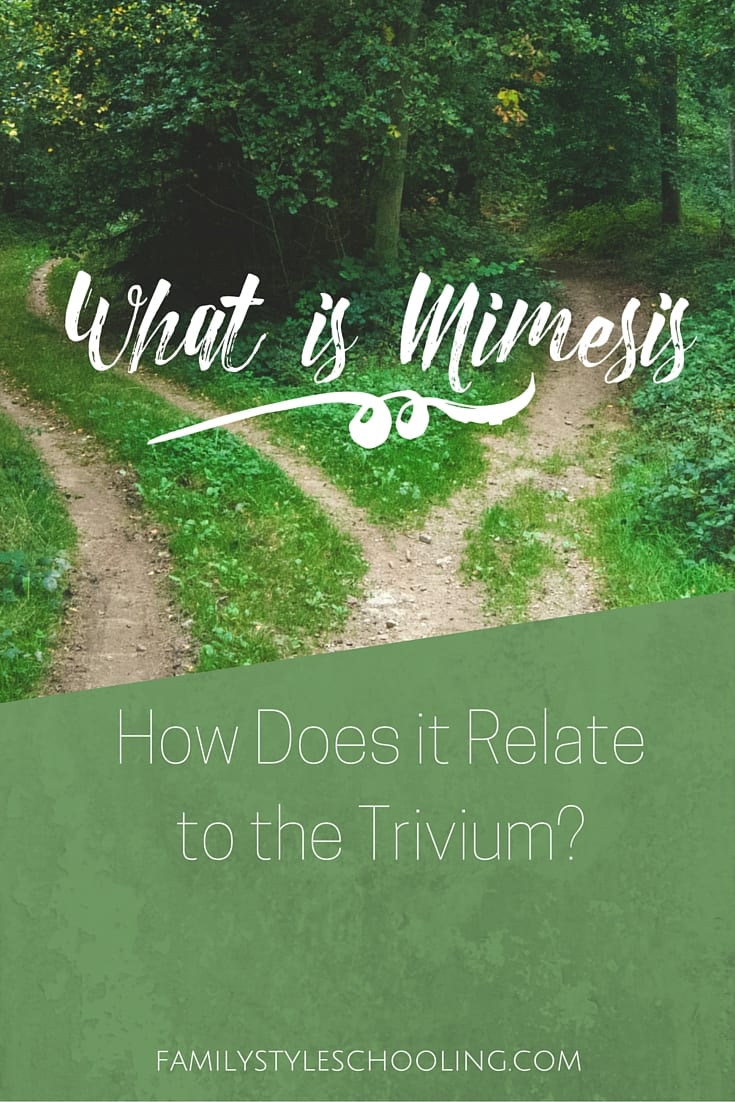What is Mimesis and How Does it Relate to the Trivium?
Today is part two of a three part series my husband is sharing with us connecting the Trivium, Mimesis, and Hermeneutics. Today he'll be defining mimesis and connecting it to the trivium that he explained yesterday. If you missed day one, click here to start reading from the beginning.

MIMESIS
Mimesis is a teaching process I’ve been learning about through the Apprenticeship Program with the CiRCE Group (the ones that gave us the LTW writing program). It’s awesome, but I’m noticing that I am having to unlearn a lot of my previous training. I have always been a part of the public school system. Even the seminary I attended was geared the same way public schools tend to be geared. I refer here primarily to the didactic lecture that begins and ends with the teacher. Typically, students sit in rows and listen to the teacher speak for a period of time, trying to take adequate notes and learn as they listen. Then they go home, look at their notes and books, and try to re-learn what they have heard…sometimes to no avail.
I do not mean to disparage the lecture entirely, as I believe it has it’s place. More specifically, I’m beginning to see that a lecture has it’s place in a larger method of teaching called the Mimetic Process. As many of you, I have benefited immensely from certain didactic lectures of this kind, but I am discovering that this is not actually how I learn. I mean, why is it that I must re-learn what I have already supposedly “learned” during the lecture? I had a pastor once that would reference his last week’s sermon by saying “what we learned last week.” The trouble was, sometimes I didn’t really remember him talking about it. I would have had to go home, look at my notes and my Bible, and try to re-learn what he was teaching. And yes, I’m using the term “re-learned” because I only supposedly learned, but don’t believe I truly learned it in the first place. This is the difference between re-learning something and reviewing it. If I had truly learned the idea being presented, then I would simply need to review it in order to apply it.
The purpose of the Mimetic Process is to actually learn.
In the Mimetic Process, teachers do the following:
1) Prepare students to hear the big idea
This is essentially creating the need, and answers, “Why is this idea important?"
2) Present the big idea to students
During this stage, didactic lectures, inductive instruction, Socratic dialogue, or other forms of presenting new material may be used. They all fit, and should be used wisely based on the audience. It is especially important during this stage that the teacher present what are called “types.”
Types are like the flesh that give shape and form to an abstract. Most ideas are abstract, and the mind MUST have a form to grasp it. For instance, if we were to try and describe “flowers” to someone who had never seen them, we would give up soon after we started. But if we brought some examples - “types” - we could teach someone exactly what “flowers” are. We can hold them up for them to see, pointing at the different parts of each type. We might let them hold them so they could feel their texture and smell their scent. The forms in their hands allow them to understand the abstract concept of “flowers.” The same is true with any new concept or skill. We can present “types” for them to see with their eyes and touch with their hands. Each type embodies the one big idea you are trying to present.
3) Give students an opportunity to Compare
It is this general step I am struggling with in my teaching, but which is required. Students are able to observe the types as they are presented, but must have an opportunity to compare the types. This comparison solidifies the idea. Both similarities and differences found reinforce the big idea the types are meant to embody. This is an essential part of their observational process. As teachers, we put the information on the table for students to see, but we must help them see it. This paradox is more common than I thought, and students will not automatically see what you see. Yet this is an assumption teachers make over and over and over. Just because it’s perfectly clear to you does not mean it is perfectly clear to them.
That’s where comparison comes in.
As they compare, they see. It forces them to look closely, to slow themselves down enough to recognize the embodied idea. There is a difference between them understanding the words you are saying and them understanding the idea you want them to know. Asking them comparison questions actually helps them see.
4) Allow students to Express the idea in their own words
Now it’s time for you as a teacher to draw out their understanding. In my experience, teachers (including myself) have either avoided this or faked it by asking leading questions - the kind of questions that subtly include the answer within the question. Yes, you know the kind:
Teacher: Julie, what did we learn about how the right ventricle of the heart pumps de-oxygenated blood to the lungs?
Julie: Well, the right ventricle is a chamber in the heart that pushes blood to the lungs to get oxygen.
Teacher: Great job!
This is not the kind of “understanding” I refer to. To be clear, I do not mean "complete knowledge,” as if they should know all the details of a thing or a process or skill. I mean that there must be a true understanding of the big idea that was presented. After comparing, ask the kind of questions that help them express the idea. They have already discussed the types themselves as they compared. Now help them really see the big idea:
Teacher: Julie, what was one difference between the two ventricles of the heart?
Julie: Well, one takes in deoxygenated blood and one pumps it out.
Teacher: Great! Where does the deoxygenated blood come from?
Julie: The body.
Teacher: What happened to the oxygen?
Julie: The body used it all.
Teacher: How does the blood get more oxygen?
Julie: The heart has to pump the blood to the lungs - the only place it can get it!
Teacher: And what happens when it picks up that oxygen?
Julie: Well, it has to come back to the heart so that it can be pumped to the rest of the body again. Wow! I’m really glad my heart does all that by itself…my whole life!
Teacher: Exactly.
Knowing that your young, non-medschool student will not know all of the details, the big idea is simple: the heart is an automatic pump. Through this expression, they interpret what they see. In other words, through expression, they verbally uncover the big idea previously hidden to them.
5) Give students opportunity to apply the idea
The term “apply” has various meanings, depending on the nature of the big idea. If the idea being presented is a skill, then the application will involve using that skill. If the idea being presented is a fact, then application may still lead to them doing something, but the action may simply be to recognize the fact when they see it. Likewise, if the idea is a concept, then application may simply be to explain or express the concept to someone else.
So in summary, the Mimetic Process is this: Present an idea and help students first observe it embodied, then interpret and then apply the idea.
THE TRIVIUM AND MIMESIS
Okay, so let me compare the Trivium and Mimesis for a second.
In the Grammar stage, students take information presented to them and learn the terms and facts, etc. That’s a lot like the Mimetic Process where an idea is presented and students are engaged on a grammar level regarding a big idea - terms are introduced, defined, and explained.
In the Dialectic stage, students are asked to process that grammar and see truths behind the terms. This is a lot like the Mimetic Process where types are compared and then the idea is expressed to draw out their understanding of it.
In the Rhetoric stage, students are asked to re-present ideas in truth and beauty based on their discoveries in the dialectic stage. This is a lot like the Mimetic Process where an idea is then practiced as a skill students can use based on their true understanding of the big idea.
Come back tomorrow for the conclusion of the discussion on the Trivium, Mimesis, and Hermeneutics.



Thanks for the effort to explain these concepts to us. You must be an excellent teacher! I feel I learned much in these two posts. Looking forward to the next.
Will be incorporating more comparison in my teaching. Is this what is considered more Socratic in method?
Thank you, Betsy and Jason.
Dee Dee, thanks! Comparison has been one of the hardest parts for me because I’ve been so used to lecture and other types where there is very little discussion. Even the meaning of the word “discussion” has been reshaped in my mind. I feel I’m unlearning and relearning a lot!
To your question, I would say that the Socratic method does incorporate comparison naturally, but it is not solely for this purpose. In general, I would say that the Socratic method can be used throughout, but the mimetic sequence seems to focus the the discussion. In the comparison stage, the sole purpose is to compare, and nothing else. In any case, one thing I’m learning is that this process is full of grace, not rules. However you choose to do it, it is really effective to help them compare the types so that they can see the big idea. All it seems to take is asking specific people specific questions about the types (not my idea, but amazingly effective). Ask really obvious questions. Again, as the teacher, everything may be completely obvious to you, but not necessarily to the students. Comparison helps clarify. It confirms. It solidifies.
I hope that helps! Thanks for your thoughts!
-Jason